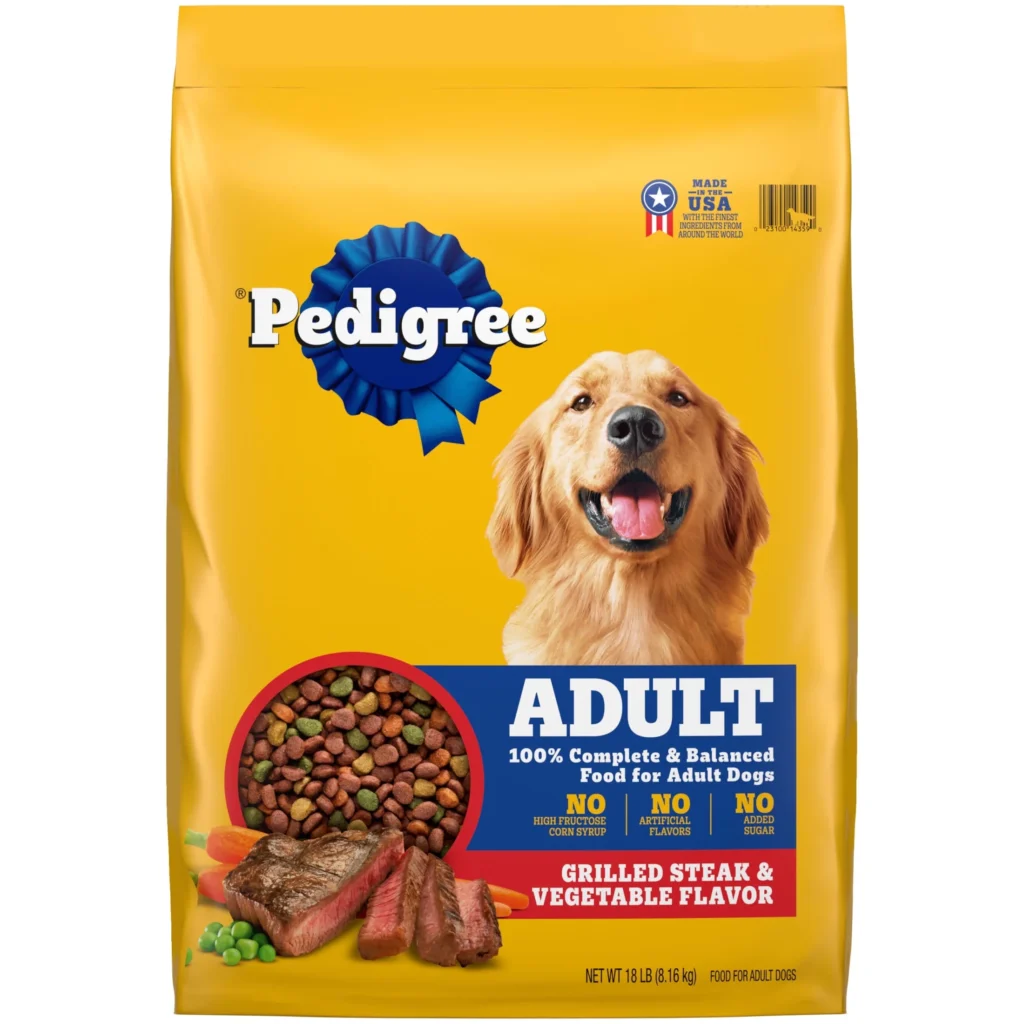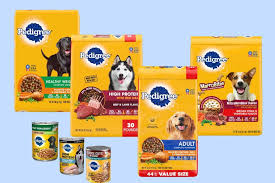Pedigree Dog Food: Is It Really the Best Choice for Your Furry Friend?
What do you want most for your dog? A shiny coat, boundless energy, and a long, happy life, right? Pedigree dog food is a well-known and easy-to-find option for dog owners. This article takes a close look at Pedigree. We will explore its ingredients, nutritional value, pros and cons. We will also check other choices, so you can choose what’s best.
Unpacking the Ingredients List: What’s Really in Pedigree Dog Food?
Let’s peek inside a bag of Pedigree. Understanding what’s in your dog’s food is super important. So, what ingredients are used? Let’s find out!

Main Protein Sources: Are They Sufficient?
Pedigree often uses meat by-products and corn gluten meal as protein sources. Meat by-products can be parts left over after processing meat. Corn gluten meal is a protein source from corn. Are these as good as whole meats, like chicken or beef? Whole meats are usually easier for dogs to digest. They also provide a more complete set of amino acids. Carbohydrates and fillers or empty calories? Common carbs in Pedigree include corn, wheat, and soy. These ingredients are often used as fillers. Fillers provide calories, but not a lot of nutrition. Some dogs are even allergic to corn, wheat, and soy. This can lead to tummy trouble or itchy skin. Are additives, preservatives, and artificial colors necessary? Pedigree sometimes includes additives like BHA and BHT. These are preservatives that help the food last longer. Artificial colors are also added to make the food look more appealing. Some studies suggest these additives might pose risks. It’s good to think about whether these ingredients are truly needed. Does Pedigree Meet Your Dog’s Needs? Does Pedigree give your dog what they need to be healthy? Let’s examine its nutritional content and health advantages. Is it really beneficial for your canine friend?
Meeting AAFCO Standards: What Does It Really Mean?
Pedigree says it meets AAFCO standards. AAFCO sets guidelines for pet food nutrition. Meeting these standards means the food has the minimum nutrients a dog needs. But, minimum doesn’t always mean best. Some foods exceed these standards, offering even better nutrition. The company Pedigree claims its food promotes healthy skin and coat, and strong bones. Do the ingredients back this up? While some ingredients may contribute to these benefits, the overall quality matters. Whole foods often provide better results than processed ingredients.
Potential Health Concerns: What to Watch Out For
Some dogs might have problems with Pedigree. Common issues include allergies and stomach ache. The fillers and additives could be to blame. Long-term, a diet lacking in nutrients may lead to other health issues.
Pros and Cons of Feeding Pedigree: A Balanced Perspective
Let’s look at the good and bad sides of feeding Pedigree. Being informed will empower you to make good choices for your pet. Here’s a balanced view.
Advantages: Affordability and Accessibility
Pedigree is often cheaper than other dog food brands. You can find it at most grocery stores. This makes it a choice for dog owners on a tight budget. It might be okay if you are in a pinch, or have a less picky eater.
Disadvantages: Ingredient Quality and Potential Health Risks
The biggest downsides are the ingredient quality and possible health risks. Fillers and additives aren’t ideal for every dog. Long-term, these ingredients could cause problems.
Alternatives to Pedigree: Exploring Better Options for Your Dog
There are alternatives to Pedigree that may be better for your dog. Let’s explore some options for improving your dog’s diet. What other foods could work?
Higher-Quality Kibble Brands: Premium Options to Consider
Consider brands that use real meat, and have few fillers. Some great brands are Orijen, Acana, and Blue Buffalo. These brands might cost more, but they often provide more nutrition.
Raw Food and Home-Cooked Diets: A More Natural Approach
Raw food diets (BARF) involve feeding your dog uncooked meat, bones, and veggies. Home-cooked diets allow you to control every ingredient. But, these diets require research to ensure they’re balanced. It’s important to chat with your vet before switching.
Making the Right Choice for Your Dog: Factors to Consider
How do you pick the best food for your dog? Many things go into making this decision. Keep these things in mind when choosing food.
Age, Breed, and Activity Level: Tailoring the Diet to Your Dog’s Needs
Puppies need different nutrients than older dogs. Small breeds may need smaller kibble. Active dogs need more calories. Match the food to your dog’s specific needs.
Consulting with Your Veterinarian: The Importance of Professional Advice
Your vet knows your dog best. They can help you pick a food that fits your dog’s needs. Always talk to your vet before changing your dog’s diet.
Conclusion
Pedigree dog food has pros and cons. It’s affordable and easy to find, but it has lower-quality ingredients. Think about your dog’s needs and do your research. A good diet is key for a happy and healthy dog.
pedigree dog food reviews
Pedigree Dog Food Review: Is It a Healthy Choice for Your Pup?
Have you ever stood in the pet food aisle, totally lost? So many choices, right? You just want the best for your furry friend. Pedigree dog food is a popular pick, easy to find and doesn’t break the bank. But is Pedigree dog food really good for your dog? This article gives you an honest look at Pedigree to help you decide.

Overview of Pedigree Dog Food.
Let’s get to know Pedigree a little better.
History and Brand Reputation
Pedigree has been around for a long time. It started in the United Kingdom way back in the 1950s. Now, it’s owned by Mars, Incorporated, a big name in the pet food world. Over the years, Pedigree has changed its recipes and expanded its product line. The brand aims to offer affordable nutrition for dogs of all ages and sizes.
Product Lines and Varieties
Pedigree offers a wide range of dog food. You can find dry food (kibble), wet food (canned), and treats. They have formulas for puppies, adult dogs, and senior dogs. Some are even made for specific breed sizes. Pedigree sometimes tweaks its formulas, so always check the label. The choices can seem endless, but it’s all about finding the right fit for your pup! Pedigree is marketed towards dog owners looking for a budget-friendly option. It’s one of the more affordable brands you’ll find in most stores. Compared to premium brands, Pedigree is definitely easier on the wallet. This makes it a popular choice for owners who need to watch their spending. What’s really in Pedigree? Now for the important part: what’s actually in Pedigree dog food?
Key Ingredients Breakdown
Looking at the ingredient list is key. Usually, the first ingredients are what make up most of the food. Many Pedigree formulas list corn as a main ingredient, along with meat by-products. These provide some protein, but they’re not the highest quality sources. You’ll also see things like soybean meal and animal fat.
Controversial Ingredients and Fillers
Some ingredients in Pedigree raise eyebrows. Corn, soy, and meat by-products are often called “fillers.” Some dog owners worry that they do not provide enough nutritional value. By-products can be leftover parts of animals, which some consider less desirable than whole meat. These ingredients aren’t necessarily harmful, but there are better options out there.
Guaranteed Analysis and Nutritional Adequacy
The guaranteed analysis tells you the percentages of protein, fat, fiber, and moisture in the food. These numbers should comply with the guidelines set by the Association of American Feed Control Officials. AAFCO ensures the food provides the basic nutrients a dog needs. While Pedigree usually meets these guidelines, the source of those nutrients matters too.
Pros and Cons of Pedigree Dog Food
Every dog food has its ups and downs. Let’s look at Pedigree. Affordability and Accessibility One of the biggest pluses of Pedigree is that it is easy to find and purchase. You can get it at almost any grocery store or pet store. If you’re on a tight budget, this can be a major advantage. You won’t have to go out of your way or spend a lot to keep your dog fed.
Palatability and Acceptance
Most dogs seem to enjoy eating Pedigree. It’s designed to be tasty, which encourages picky eaters to dig in. If your dog gobbles it down without hesitation, that’s a good sign. However, taste alone doesn’t mean it’s the healthiest choice. Potential Health Concerns Some dogs might have problems with Pedigree. Allergies or sensitivities to ingredients like corn or soy are possible. Some owners report digestive issues like gas or loose stool. If you notice any of these signs, it might be time to switch foods. Cheaper ingredients can sometimes lead to lower nutrient absorption too.
Real-World Reviews and Testimonials
What do other dog owners think about Pedigree?
Analysis of Customer Reviews
Online reviews are mixed. Some owners say their dogs have thrived on Pedigree for years. Others complain about skin problems, digestive upset, or a general lack of energy. It’s important to remember that every dog is different. What works for one might not work for another.
Case Studies or Success Stories
Finding concrete case studies about Pedigree is tough. However, many owners share anecdotes about their dogs doing well on the food. These stories often highlight the convenience and affordability of Pedigree. If your dog is healthy and happy on it, that’s a good sign!
Expert Opinions and Veterinarian Recommendations
Most vets recommend higher-quality dog foods with better ingredients. You won’t often find vets specifically recommending Pedigree. They often suggest looking for foods with whole meat sources, fewer fillers, and a balanced nutritional profile. While Pedigree meets basic requirements, it may not be the best option for optimal health.
Alternatives to Pedigree Dog Food
If you’re not sure about Pedigree, here are some other options.
Similar Brands in the Same Price Range
If you’re looking for something similarly priced, consider brands like Purina Dog Chow or Kibbles ‘n Bits. These offer comparable affordability and availability. Just remember to check their ingredient lists too!
Higher-Quality Options for Improved Nutrition
If you’re willing to spend a bit more, you can find dog foods with better ingredients. Look into brands like Blue Buffalo, Wellness, or Merrick. These often feature whole meats, fruits, and vegetables. They may be a better choice for dogs with sensitivities or those needing a nutritional boost.
Conclusion
So, is Pedigree a healthy choice for your pup? It’s an affordable and accessible option that meets basic nutritional needs. Many dogs do fine on it. However, it’s not the highest-quality food out there. The ingredients aren’t the best, and some dogs may have sensitivities. Consider your dog’s individual needs and budget. Talk to your vet about what’s best for your furry friend!
pedigree dog food ingredients

Pedigree Dog Food Ingredients: Unveiling What’s Really in Your Dog’s Bowl
Did you know that many dog owners worry about what’s in their furry friend’s food? With so many choices, figuring out what’s best can feel tough. This concern has led to more people checking ingredient labels. Pedigree is a well-known brand. What’s really inside their dog food? This article will give you a clear look at Pedigree dog food ingredients. You’ll get an unbiased analysis. This should help you decide if it’s the right choice for your dog.
Decoding the Ingredient Label: A beginner’s guide
Understanding a dog food label is very important. It lets you know what you’re feeding your pet. Where do you even start?
Ingredient Order Matters
Ingredients are listed by weight. The heaviest ones are at the top. Water content counts. So, a meat listed first might not be as significant after cooking removes moisture. Keep this in mind when you see “chicken” at the top.
Common Misleading Terms
“Meat by-products” can sound scary. These are the non-muscle parts of animals. Think organs. “Animal digest” is a liquid or powder that is made from animal tissues. These add flavor. “Fillers” are ingredients that don’t add much nutrition. Some examples are corn and soy.
AAFCO Standards
AAFCO sets standards for pet food. They make sure dog foods are nutritionally complete. Look for the AAFCO statement on the food label. It confirms the food meets the basic needs for a specific life stage. The key ingredients in Pedigree dog food are as follows: A detailed breakdown What proteins, fats, and carbohydrates are commonly used? Protein sources Pedigree uses different protein sources. Meat meals are common. These are made by cooking and drying animal tissues. Plant-based proteins like corn gluten meal are also used. Meat provides essential amino acids. These are critical for muscle growth. Carbohydrates Grains like corn and wheat are often in Pedigree. These give energy. Some formulas use rice. Carbs provide fiber. This supports healthy digestion. pedigree dog food
Fats and Oils
Fats come from sources like soybean oil and animal fat. They give energy. Fats help with coat health. They also support vitamin absorption. Separating Fact from Fiction: Some ingredients in Pedigree raise eyebrows. Are these concerns valid? Let us investigate. pedigree dog food
Corn and Wheat Corn and wheat
are often called “fillers”. Some dogs are allergic. However, these grains can provide energy and fiber. The quality and amount matter. pedigree dog food
Artificial Colors and Preservatives
Artificial colors make food look appealing. Preservatives keep food fresh. Some people worry about their health effects. Look for formulas without these additives if you’re concerned. By-Products By-products are organ meats and other non-muscle parts. They can be nutritious. They offer vitamins and minerals. Quality is important. Is Pedigree a balanced diet? Does Pedigree provide a balanced diet for dogs? Let’s break down the nutritional profile. pedigree dog food
Macronutrient Ratios
Dog food should have the right balance of protein, fat, and carbs. AAFCO sets guidelines. Check the guaranteed analysis on the label. This shows the percentages of each. pedigree dog food
Micronutrients
vitamins and minerals are essential. Pedigree adds these. They support overall health. Calcium, phosphorus, and vitamin E are examples. pedigree dog food
Life Stage Considerations
Pedigree makes food for puppies, adults, and senior dogs. Each life stage has different needs. Puppy food has more protein. Senior food has fewer calories. pedigree dog food
Alternatives and Comparisons: Exploring Other Options

How does Pedigree compare to other dog foods? Let’s look at some alternatives.
Price Point Comparison
Pedigree is often more affordable. Premium brands cost more. You get what you pay for. Sometimes, this means better ingredients. pedigree dog food
Ingredient Quality Comparison
Premium brands may use higher-quality ingredients. They might use named meat sources. They may also skip artificial additives. Pedigree is more budget-friendly. pedigree dog food
Customer Reviews and Ratings
Many customers are happy with Pedigree. Some worry about the ingredients. Reading reviews can provide helpful insights. pedigree dog food
Conclusion
So, what’s the final verdict on Pedigree dog food ingredients? Pedigree offers an affordable option. It meets basic nutritional needs for many dogs. However, some ingredients raise concerns. Consider your dog’s specific needs. Talk to your vet. Making an informed choice ensures your dog stays happy and healthy.

